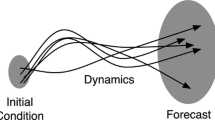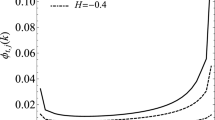Abstract
The effective action provides an appropriate cost function to determine most probable (or optimal) histories for nonlinear dynamics with strong noise. In such strong-coupling problems, a nonperturbative technique is required to calculate the effective action. We have proposed a Rayleigh–Ritz variational approximation, which employs simple moment-closures or intuitive guesses of the statistics to calculate the effective action. We consider here an application to climate dynamics, within a simple “bimodal” Langevin model similar to that proposed by C. Nicolis and G. Nicolis [Tellus 33:225 (1981)]. Capturing climate state transitions even in this simple model is known to present a serious problem for standard methods of data assimilation. In contrast, it is shown that the effective action for the climate history is already well-approximated by a one-moment closure and that the optimal, minimizing history robustly tracks climate change, even with large observation errors. Furthermore, the Hessian of the effective action provides the ensemble variance as a realistic measure of confidence level in the predicted optimal history.
Similar content being viewed by others
REFERENCES
L. Onsager, Reciprocal relations in irreversible processes, I, II, Phys. Rev. 37:405–426, 2265–2279 (1931).
L. Onsager and S. Machlup, Fluctuations and irreversible processes, Phys. Rev. 91: 1505–1512 (1953).
M. I. Freidlin and A. D. Wentzell, Random Perturbations of Dynamical Systems (Springer, New York, 1984).
R. Graham, Onset of cooperative behavior in nonequilibrium steady states, in Order and Fluctuations in Equilibrium and Nonequilibrium Statistical Mechanics, G. Nicolis, G. Dewel, and J. W. Turner, eds. (Wiley, New York, 1981).
R. Maier and D. Stein, A scaling theory of bifurcations in the symmetric weak-noise escape problem, J. Stat. Phys. 83:291–357 (1996).
C. Nicolis and G. Nicolis, Stochastic aspects of climatic transitions—additive fluctuations, Tellus 33:225–234 (1981).
R. Benzi, G. Parisi, A. Sutera, and A. Vulpiani, Stochastic resonance in climatic change, Tellus 34:10–16 (1982).
R. Benzi, G. Parisi, A. Sutera, and A. Vulpiani, A theory of stochastic resonance in climatic change, SIAM J. Appl. Math. 43:565–578 (1983).
A. Sutera, Stochatic perturbation of a pure convective motion, J. Atmos. Sci. 37:246–249 (1980).
A. Sutera, On stochastic perturbation and long-term climate behavior, Quart. J. Roy. Meteorol. Soc. 107:137–152 (1981).
R. N. Miller, M. Ghil, and V. Gauthiez, Advanced data assimilation in strongly nonlinear dynamical systems, J. Atmos. Sci. 51:1037–1056 (1994).
M. Ghil and P. Malanotte-Rizzoli, Data assimilation in meteorology and oceanography, Adv. in Geophys. 33:141–266 (1991).
O. Talagrand, Assimilation of observations, an introduction, J. Met. Soc. Jap. 75:191–209 (1997).
A. H. Jazwinski, Stochastic Processes and Filtering Theory (Academic Press, New York, 1970).
Y. Steinberg, B. Z. Bobrovsky, and Z. Schuss, Fixed-point smoothing of scalar diffusions, I: An asymptotically optimal smoother, SIAM J. Appl. Math. 54:833–853 (1994).
G. L. Eyink, A variational formulation of optimal nonlinear estimation, preprint.
G. L. Eyink and J. Restrepo, Optimal variational assimilation in strongly nonlinear dynamical systems, to be submitted to J. Atmos. Sci.
E. N. Lorenz, Deterministic non-periodic flow, J. Atmos. Sci. 20:130–141 (1963).
H. J. Kushner, Dynamical equations for optimal nonlinear filtering, J. Diff. Eq. 3:179–190 (1967).
E. Pardoux, Non-linear filtering, prediction and smoothing, in Stochastc Systems: The Mathematics of Filtering and Identification and Applications, M. Hazelwinkel and J. C. Willems (D. Reidel Publishing, Dordrecht, 1981).
G. L. Eyink, Action principle in nonequilibrium statistical dynamics, Phys. Rev. E 54:3419–3435 (1996).
G. L. Eyink, Linear stochastic models of nonlinear dynamical systems, Phys. Rev. E 58:6975–6991 (1998).
G. L. Eyink, Action principle in statistical dynamics, Prog. Theor. Phys. Suppl. 130:77–86 (1998).
G. L. Eyink, Fluctuation-response relations for multi-time correlations, to appear in Phys. Rev. E 62:210–220 (2000).
H. Cramér, Sur un noveau theorème-limite de la théorie des probabilitiés, Actualités Scientifiques et Industrialles 736:5–23 (1938).
U. Frisch, Turbulence. The Legacy of A. N. Kolmogorov (Cambridge University Press, Cambridge, 1995).
G. L. Eyink and A. Wray, Evaluation of the statistical Rayleigh Ritz method in isotropic turbulence decay, in Proceedings of the 1998 CTR Summer Program (Center for Turbulence Research, NASA Ames & Stanford University, 1998). Available at: http://ctr. stanford.edu/SP98.html.
C. Nicolis and G. Nicolis, Closing the hierarchy of moment equations in nonlinear dynamical systems, Phys. Rev. E 58:4391–4400 (1998).
K. E. Kürten and G. Nicolis, Moment equations and closure schemes in chaotic dynamics, J. Phys. A: Math. Gen. 31:7331–7340 (1998).
P. J. van Leeuwen and G. Evensen, Data assimilation and inverse methods in terms of a probabilistic formulation, Mon. Wea. Rev. 124:2898–2912 (1996).
G. Evensen, Advanced data assimilation for strongly nonlinear dynamics, Mon. Wea. Rev. 125:1342–1354 (1996).
G. Burgers, P. J. van Leeuwen, and G. Evensen, Analysis scheme in the ensemble Kalman filter, Mon. Wea. Rev. 126:1719–1724 (1998).
H. J. Kushner, Approximations to optimal nonlinear filters, IEEE Trans. Auto. Cont. AC-12:546–556 (1967).
Author information
Authors and Affiliations
Rights and permissions
About this article
Cite this article
Eyink, G.L., Restrepo, J.M. Most Probable Histories for Nonlinear Dynamics: Tracking Climate Transitions. Journal of Statistical Physics 101, 459–472 (2000). https://doi.org/10.1023/A:1026437432570
Issue Date:
DOI: https://doi.org/10.1023/A:1026437432570




